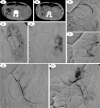Emergency Transcatheter Arterial Embolization for Acute Renal Hemorrhage
- PMID: 26496273
- PMCID: PMC4620825
- DOI: 10.1097/MD.0000000000001667
Emergency Transcatheter Arterial Embolization for Acute Renal Hemorrhage
Abstract
The aims of this study were to identify arteriographic manifestations of acute renal hemorrhage and to evaluate the efficacy of emergency embolization. Emergency renal artery angiography was performed on 83 patients with acute renal hemorrhage. As soon as bleeding arteries were identified, emergency embolization was performed using gelatin sponge, polyvinyl alcohol particles, and coils. The arteriographic presentation and the effect of the treatment for acute renal hemorrhage were analyzed retrospectively. Contrast extravasation was observed in 41 patients. Renal arteriovenous fistulas were found in 12 of the 41 patients. In all, 8 other patients had a renal pseudoaneurysm, 5 had pseudoaneurysm rupture complicated by a renal arteriovenous fistula, and 1 had pseudoaneurysm rupture complicated by a renal artery-calyceal fistula. Another 16 patients had tumor vasculature seen on arteriography. Before the procedure, 35 patients underwent renal artery computed tomography angiography (CTA). Following emergency embolization, complete hemostasis was achieved in 80 patients, although persistent hematuria was present in 3 renal trauma patients and 1 patient who had undergone percutaneous nephrolithotomy (justifying surgical removal of the ipsilateral kidney in this patient). Two-year follow-up revealed an overall effective rate of 95.18 % (79/83) for emergency embolization. There were no serious complications. Emergency embolization is a safe, effective, minimally invasive treatment for renal hemorrhage. Because of the diversified arteriographic presentation of acute renal hemorrhage, proper selection of the embolic agent is a key to successful hemostasis. Preoperative renal CTA plays an important role in diagnosing and localizing the bleeding artery.
Conflict of interest statement
There are no conflicts of interest in this study.
Figures





References
-
- Sommer CM, Stampfl U, Bellemann N, et al. Patients with life-threatening arterial renal hemorrhage: CT angiography and catheter angiography with subsequent superselective embolization. Cardiovasc Intervent Radiol 2010; 33:498–508. - PubMed
-
- Zugazagoitia J, Sastre J, Barrera J, et al. Severe perirenal hematoma in a patient with a single kidney treated with sunitinib for metastatic pancreatic neuroendocrine tumor. J Cancer Res Ther 2012; 8:303–305. - PubMed
-
- Springer C, Hoda MR, Fajkovic H, et al. Laparoscopic vs open partial nephrectomy for T1 renal tumours: evaluation of long-term oncological and functional outcomes in 340 patients. BJU Int 2013; 111:281–288. - PubMed
-
- Keeling AN, McGrath FP, Thornton J, et al. Emergency percutaneous transcatheter embolisation of acute arterial haemorrhage. Ir J Med Sci 2010; 179:385–391. - PubMed
-
- Koganemaru M, Abe T, Iwamoto R, et al. Ultraselective arterial embolization of vasa recta using 1.7-French microcatheter with small-sized detachable coils in acute colonic hemorrhage after failed endoscopic treatment. Am J Roentgenol 2012; 198:W370–372. - PubMed
Publication types
MeSH terms
LinkOut - more resources
Full Text Sources
Medical
Research Materials

